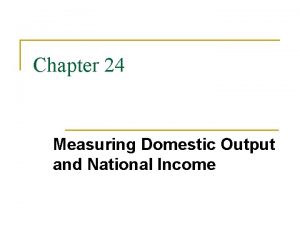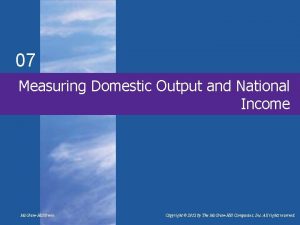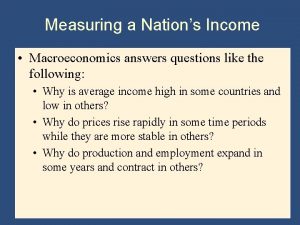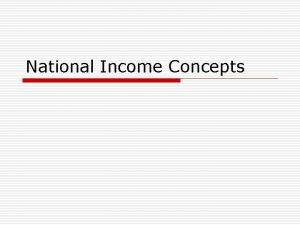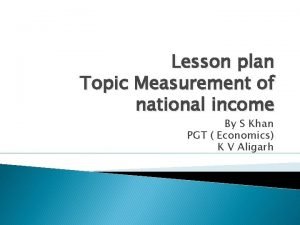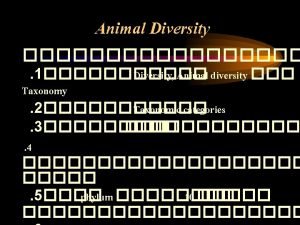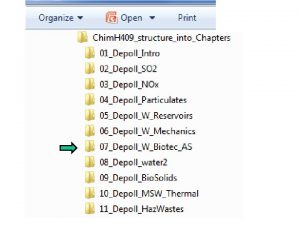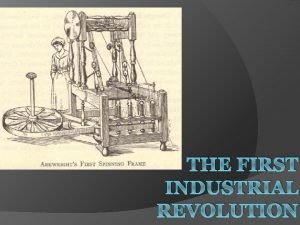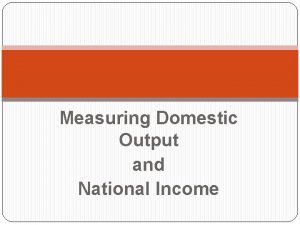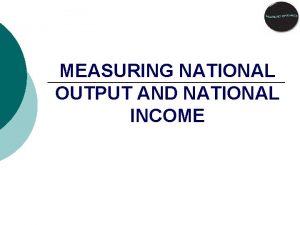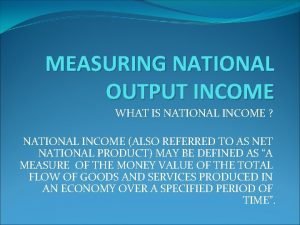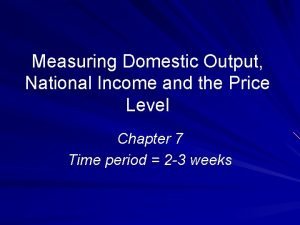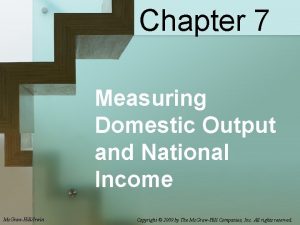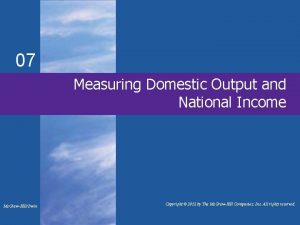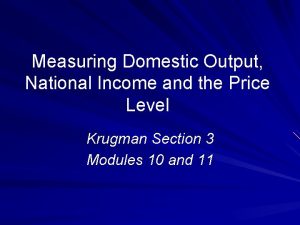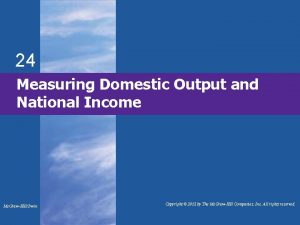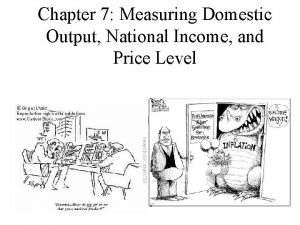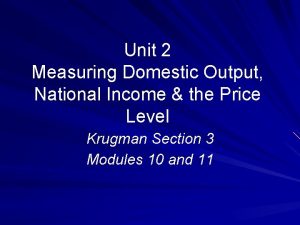07 Measuring Domestic Output and National Income Mc






































- Slides: 38

07 Measuring Domestic Output and National Income Mc. Graw-Hill/Irwin Copyright © 2012 by The Mc. Graw-Hill Companies, Inc. All rights reserved.

Assessing the Economy’s Performance • National Income Accounting measures • LO 1 economy’s overall performance Bureau of Economic Analysis compiles National Income and Product Accounts • Assess health of economy • Track long run course • Formulate policy 7 -2

Stocks versus flows Stock variables are cumulated values measured at a specific point in time. Examples: Bank balances, debt, inventories. Flow variables are measured per unit of time. Examples: Income (including profits), spending, output.

Gross Domestic Product • Measure of aggregate output • Monetary measure • Avoid multiple counting • Market value final goods • Ignore intermediate goods • Count value added LO 1 7 -4

Gross Domestic Product (GDP) GDP is the market value of new, final goods and services produced year within the nation’s borders in a given time period. GDP is our basic measure of economic activity

Final versus Intermediate Goods A final good or service is produced for a final user and not as a component of a final good. Examples: Cars, pizzas, luggage An intermediate good or service is used as a component of a final good or service Examples: Radiator hoses, flour, plastics.

Value Added At each stage of production, the selling price of a product minus the cost of intermediate goods purchased from other firms. Value-added is equivalent to the factor income earned by resource owners at a particular stage of production (like oil drilling).

Computation of value added for a new desk Stage of Production Logger Miller Manufacturer Retailer (1) Sale Value (2) Cost of Intermediate Goods (3) Value Added $20 50 120 200 $20 50 120 $20 30 70 80 Market value of final good $200 The value added at each stage of production is the sale price at that stage minus the cost of intermediate goods, or column (1) minus column (2). The value added at each stage sum to the market value of the final good. 8

To count the desk in GDP, we count the final transaction only. Otherwise, we would be counting value added twice.

Gross Domestic Product • Exclude financial transactions • Public transfer payments • Private transfer payments • Stock (and bond) market • LO 1 transactions Exclude second hand sales • Sell used car to a friend 7 -10

Transfer Payments • “Needs-tested. ” Examples: TANF, Medicaid, food stamps, unemployment compensation. • Entitlements. Examples: Social Security, Medicare 11

Two Approaches to GDP • Income approach • Count income derived from • LO 2 production • Wages, rental income, interest income, profit Expenditure approach • Count sum of money spent buying the final goods • Who buys the goods? 7 -12

Two Approaches to GDP Expenditures or Output Approach Income or Allocations Approach Consumption by Households Wages Investment by Businesses Rents + + Government Purchases + Expenditures By Foreigners LO 2 G = D= P + + Interest Profits Statistical Adjustments 7 -13

Expenditures Approach • Personal consumption expenditures (C) • Durable consumer goods • Nondurable consumer goods • Consumer expenditures for services • Domestic plus foreign goods produced LO 2 7 -14

Consumer Spending by Type, 2009 (in billions) Total spending by U. S. households in 2009 was a $10. 1 trillion Source: Bureau of Economic Analysis

Expenditures Approach • Gross private domestic investment (Ig) • Machinery, equipment, and tools • All construction • Changes in inventories • Creation of new capital assets • Noninvestment transactions excluded LO 2 7 -16

Measuring Inventory Investment This firm had positive inventory investment of $10, 000 in 2012. $100, 000 December 31, 2011 $110, 000 December 31, 2012

Expenditures Approach - = Gross Investment Depreciation Net Investment Gross Investment Net Investment Depreciation Increase LO 2 Stock of Capital Consumption & Government Spending January 1 Year’s GDP Stock of Capital December 31 7 -18

Expenditures Approach • Government purchases (G) • Expenditures for goods and services • Expenditures for publicly owned capital • Excludes transfer payments • Net exports (Xn) • Add exported goods • Subtract imported goods • Xn = exports – imports • GDP = C + Ig + G + Xn LO 2 7 -19

U. S. Economy 2009 In Billions Receipts Expenditures Approach Allocations Income Approach Personal Consumption (C) $10, 089 Compensation $ 7792 Gross Private Domestic Rents 268 788 Investment (Ig) 1628 Interest Government Purchases (G) 2931 Proprietor’s Income 1041 Net Exports (Xn) -392 Corporate Profits 1309 Taxes on Production and Imports National Income 1090 $12, 288 Net Foreign Factor Income (-) 105 Statistical Discrepancy (+) 209 Consumption of Fixed Capital (+) Gross Domestic Product $ 14, 256 LO 2 Gross Domestic Product 1864 $ 14, 256 7 -20

Comparative GDP See new IMF data for 2012. data. Also see GDP per capita: LO 2 7 -21

The Income Approach • Compensation of employees • Rents • Interest • Proprietor’s income • Corporate profits • Corporate income taxes • Dividends • Undistributed corporate profits • Taxes on production and imports LO 2 7 -22

The Income Approach LO 2 • From national income to GDP • Subtract net foreign factor income • Statistical discrepancy • Consumption of fixed capital • Other national accounts • Net domestic product (NDP) • National income (NI) • Personal income (PI) • Disposable income (DI) 7 -23

U. S. Income Relationships 2009 Gross Domestic Product (GDP) Less: Consumption of Fixed Capital Equals: Net Domestic Product (NDP) Less: Statistical Discrepancy Plus: Net Foreign Factor Income Equals: National Income (NI) Less: Taxes on Production and Imports Less: Social Security Contributions Less: Corporate Income Taxes Less: Undistributed Corporate Profits Plus: Transfer Payments Equals: Personal Income (PI) Less: Personal Taxes Equals: Disposable Income (DI) LO 2 $ 14, 256 1864 $ 12, 392 209 105 $ 12, 288 1090 967 315 418 2528 $ 12, 026 1102 $ 10, 924 7 -24

Circular Flow Revisited LO 2 7 -25

Nominal vs. Real GDP • GDP is a dollar measure of • • • LO 3 production Using dollar values creates problems Nominal GDP • Use prevailing price Real GDP • Reflect changes in price • Use base year price 7 -26

GDP Price Index • Use price index to determine real GDP Price Index In Given Year Real GDP LO 3 = = Price of Market Basket In Specific Year Price of Same Basket In Base Year x 100 Nominal GDP Price Index (in hundredths) 7 -27

GDP Price Index • LO 3 Calculating Real GDP (Base Year = Yr 1) (5) Adjusted, or Real, GDP Year (1) Units of Output (2) Price of Pizza Per Unit (3) Price Index (Year 1 = 100) (4) Unadjusted, or Nominal, GDP (1) X (2) 1 5 $10 100 $ 50 $50 2 7 20 200 140 70 3 8 25 250 200 80 4 10 30 --- --- 5 11 28 --- --7 -28

GDP per Person in the United States www. economagic. com


The residential construction industry is in a major slump. 2005 = 100

Net Exports (NX) of the U. S. (Monthly)


Shortcomings of GDP • Nonmarket activities • Leisure • Improved product quality • The underground economy • GDP and the environment • Composition and distribution of the • LO 4 output Noneconomic sources of well-being 7 -34

Underground Economy LO 4 7 -35

Sources of BEA Data • Consumption • Census Bureau’s Retail Trade Survey • Census Bureau’s Survey of Manufacturers • Census Bureau’s Service Survey • Industry Trade Sources LO 4 7 -36

Sources of BEA Data • Investment • All consumption data sources • Census Bureau’s Housing Starts Survey and Housing Sales Survey • Retail Trade Survey • Wholesale Trade Survey • Survey of Manufacturing LO 4 7 -37

Sources of BEA Data • Government Purchases • Office of Personnel Management • Construction Surveys • Census Bureau’s Survey of • LO 4 Government Finance Net Exports • U. S. Customs Service • BEA Surveys and Analysis 7 -38
 Measuring domestic output and national income
Measuring domestic output and national income Measuring domestic output and national income
Measuring domestic output and national income Measuring domestic output and national income
Measuring domestic output and national income Measuring domestic output and national income
Measuring domestic output and national income Personal income formula
Personal income formula What is gnp and gdp
What is gnp and gdp Measuring a nation's income
Measuring a nation's income 30% income tax
30% income tax Operating income examples
Operating income examples Accounting income vs taxable income
Accounting income vs taxable income The national income and product accounts
The national income and product accounts Ano ang kahulugan ng income approach
Ano ang kahulugan ng income approach National income formula
National income formula National income lesson plan
National income lesson plan National income formula
National income formula National income tax workbook
National income tax workbook Solve the national income model by matrix inversion
Solve the national income model by matrix inversion National income data
National income data What is national income
What is national income National income accounting equation
National income accounting equation National unification and the national state
National unification and the national state Income approach
Income approach Soil conservation and domestic allotment act
Soil conservation and domestic allotment act Soil conservation and domestic allotment act
Soil conservation and domestic allotment act What is the taxonomy of a domestic dog
What is the taxonomy of a domestic dog Domestic and family violence protection act 2012
Domestic and family violence protection act 2012 Soil conservation and domestic allotment act
Soil conservation and domestic allotment act Domestic and family violence protection act 2012
Domestic and family violence protection act 2012 Chapter 7 domestic and family violence assessment
Chapter 7 domestic and family violence assessment Define international human resource management
Define international human resource management Difference between hrm and ihrm
Difference between hrm and ihrm Characteristics of ihrm
Characteristics of ihrm Horse gives us
Horse gives us Typical composition of untreated domestic wastewater
Typical composition of untreated domestic wastewater Domestic system
Domestic system Domestic system
Domestic system Rainwater harvesting system ireland
Rainwater harvesting system ireland William h taft domestic policy
William h taft domestic policy Strategy is
Strategy is
